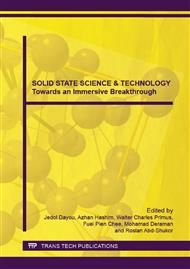p.181
p.187
p.194
p.200
p.205
p.211
p.217
p.223
p.230
Effects of Different Concentration in (w/v)% of Carboxymethyl Iota-Carrageenan Based Green Polymer Electrolyte
Abstract:
The effect of different concentrations in weight per volume percentage, (w/v)% of iota-carrageenan and carboxymethyl-iota carrageenan used as the green polymer electrolyte has been studied. The polymer electrolyte films were prepared by solution casting technique. Different concentration in the range from 1.0 – 6.0 (w/v)% were dissolved in fix volume of acetic acid which act as solvent. The films have been analyzed through attenuated Fourier transform infrared (FTIR) spectroscopy, X-ray diffraction (XRD) measurement and electrochemical impedance spectroscopy (EIS). The EIS results showed that the ionic conductivity increased as the concentration of the polymer increases. In comparison between iota-carrageenan and carboxymethyl iota-carrageenan, carboxymethyl-iota carrageenan showed better results due to the presence of more active site. The highest conductivity achieved by iota-carrageenan and carboxymethyl iota-carrageenan were 3.45 × 10-6 S cm-1 and 9.57 × 10-4 S cm-1 at the concentration 3.0 and 4.0 (w/v)% , respectively. From the FTIR spectra, it depicts that the intensity of significant peaks of ether and carboxylate group increases as the concentration of polymer increases. The XRD analysis showed that as the concentration of polymer increase, the amorphous region in the films would be enhanced. This study showed that the concentration play significant role in the ionic conductivity improvement.
Info:
Periodical:
Pages:
205-210
Citation:
Online since:
June 2015
Price:
Сopyright:
© 2015 Trans Tech Publications Ltd. All Rights Reserved
Share:
Citation:


